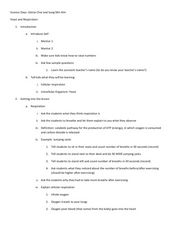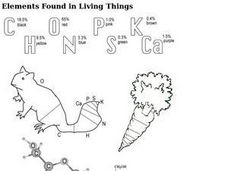K12 Reader
What’s in Your Cells?
Organelles, cellular respiration, ATP, and DNA. The passage attached to this life science reading comprehension worksheet is all about cells. After reading about diffusion and osmosis, kids answer a series of questions based on the text.
Curated OER
Photosynthesis
In this biology worksheet, students explain where the energy of food originally came from. Then the explain one of the principal chemical compounds that living things use to store energy. Students also describe how ATP and ADP differ and...
Curated OER
Cellular Respiration and Photosynthesis
For this cellular respiration and photosynthesis worksheet, students read through the presented material and draw an illustration of the production of ATP. Students answer several short answer questions about the production of ATP,...
Curated OER
Metabolism Test Review
In this metabolism test review, students define several terms. Students write balanced chemical equations for aerobic cellular respiration. Students complete several multiple choice questions.
Curated OER
Yeast and Respiration
Students explore oxygen properties by conducting a cell experiment in class. In this respiration lesson, students discuss the process of breathing and how oxygen is inhaled before carbon dioxide is exhaled. Students utilize yeast, water,...
Curated OER
Hand Writing: Three Letter Words
In this printing practice worksheet, students trace, form, and print three letter words. Students practice printing ten separate words.
Curated OER
Moore S Word Search Puzzle 1
For this literacy worksheet, students find the words that are in the word search puzzle that focus upon the vocabulary that is from the theme of the sheet.
Curated OER
RP Word Search Puzzle
In this literacy learning exercise, students find the words that are related to the concepts that are the theme of the word search. New vocabulary is the focus of the puzzle.
Curated OER
Elements Found in Living Things
For this elements worksheet, students review the most common elements found in living things. Students color in two pictures with the percentages of the elements found in that living thing.







